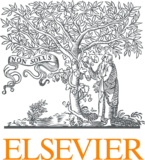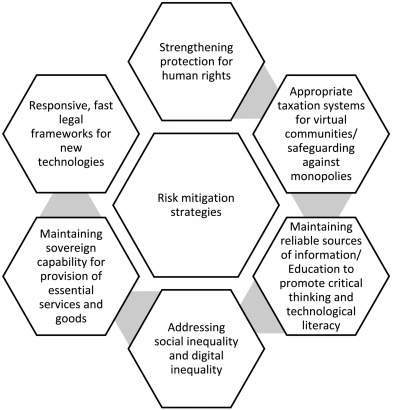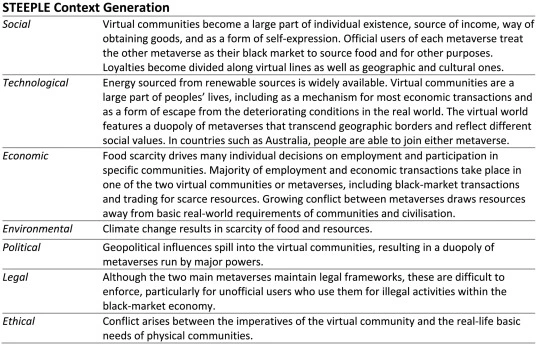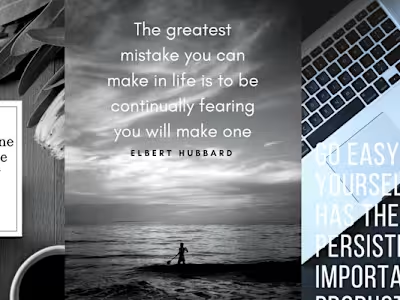Stories and systems: Exploring technological impact in complex …

Under a Creative Commons license
open access
Highlights
•Considers the value of storytelling within the frame of systems thinking.
•Research team includes working practitioners of creative writing.
•Offers perspectives on science fiction and futures thinking.
Abstract
This research article argues for the effectiveness of storytelling techniques not only for communicating complex systems, but also for analysing complex systems and modelling outcomes. This kind of analysis and modelling of impacts is vital in strategic decision making and technology foresight. Strategy engages at many points with complex sociotechnical systems. Disruptive technological impact does not necessarily inhere in the technological objects or capabilities themselves. Rather, disruption arises from a convergence of factors including social, human, and ethical considerations. These factors are manifold, difficult (if not impossible) to predict, and—when it comes to the actions of individuals—informed by unknowable subjective personal histories, experiences, and current circumstances. Faced with such opaque and constantly shifting contextual factors, foreseeing technological impact presents challenges that are difficult to surmount. We show how the techniques of storytelling shed light on those challenges.
Keywords
Foresight
Storytelling
Creative writing
Technology
Speculative fiction
1. Introduction
This paper argues for the effectiveness of storytelling techniques not only for communicating complex systems, but also for analysing complex systems and modelling outcomes. This kind of analysis and modelling of impacts is vital in strategic decision making and technology foresight. Strategy engages at many points with complex sociotechnical systems. Disruptive technological impact does not necessarily inhere in the technological objects or capabilities themselves. Rather, disruption arises from a convergence of factors including social, human, and ethical considerations. These factors are manifold, difficult (if not impossible) to predict, and—when it comes to the actions of individuals—informed by unknowable subjective personal histories, experiences, and current circumstances. Faced with such opaque and constantly shifting contextual factors, foreseeing technological impact presents challenges that are difficult to surmount. How might the techniques of storytelling shed light on those challenges?
In recent years, an increasing urgency has arisen across multiple sectors and disciplines about the value of learning how to tell a story. Recent research around storytelling's uses for communication has been undertaken in the fields of political lobbying (Holdo, 2019), organisational psychology (Griffiths et al., 2021), and agriculture (Thomson et al., 2019). Indeed, the ‘highly complicated problem’ of climate change is often singled out as a place where storytelling can make its mark: ‘in order to make the fight against climate change a priority, climate advocates need to tell stories, to mobilize people and guide their actions’. (Arnold, 2018)
Storytelling, however, is not reducible only to communication. Stories are complex systems in themselves, where events, people, and their circumstances converge and mutually influence one another. As such, we argue that they are highly suitable for use in analysing complex systems, functioning as what Franco calls ‘boundary objects’: models to support cross-disciplinary collaboration in complex problem solving (Alberto Franco, 2013a). Techniques from storytelling may be used to frame and imagine outcomes, including weaknesses in systems, and model the effects of different resources and mitigation strategies. Storytelling, too, introduces the element of play to systems analysis, providing a set of key terms and strategies for asking ‘what if’ and ‘what then’. Research has shown that play is an essential enabler of adaptability in humans (Brown, 2009).
Storytelling, then, can be seen as an effective tool for transdisciplinary exploration and communication of complex systems, towards improved decision making in areas such as strategic planning and technology foresight. For this kind of use, storytelling is poorly understood. This article seeks to enhance that understanding as a transdisciplinary collaboration between operations research practitioners and a team of professional storytellers.
We have structured this article in two parts. In the first part, we outline the historical context and the key principles of systems thinking, pointing out that, within the framework of systems thinking, stories help transcend different types of boundaries in transdisciplinary settings. We also discuss the key principles of storytelling – character, conflict, context – building an argument for the value of stories in exploring complex systems. In the second part of the article, we present an example of a practical application of stories as boundary objects for strategic technology foresight, demonstrating the value of storytelling in complex systems analysis.
2. Systems thinking for dealing with real-world problems
2.1. Complex systems and technology foresight/strategic planning
The grand challenge for strategic planners, futurists, technology analysts, and capability developers in the twenty-first century has been to grapple with what are often referred to as ‘wicked’ problems. Rittel (Rittel, 1972) contrasts wicked problems with ‘tame’ problems, which can be defined objectively, and which have testable solutions. Wicked problems, on the other hand, arise in situations with ill-defined socio-technical contexts, multiple stakeholders, and conflicting goals; these problems cannot be ‘solved,’ but do need to be managed (Ackoff, 1979). Examples that are instantly recognisable as not being entirely amenable to controlled experimentation or mathematical optimisation include climate change (ElSawah, 2010a), engineering disasters such as the Fukushima reactor meltdown (Camelia, 2016), (Reynolds and Holwell, 2010) or the COVID-19 pandemic (Marshall et al., 2023). The notions of wicked problems and complex systems are paramount in strategic planning and technology foresight, because the impact of specific strategic decisions and emerging technologies cannot be assessed through the scientific and technical body of knowledge alone. Human emotions and perspectives, social and cultural effects, political and ideological affiliations all play an important role in broader social, economic, and political trends. Similarly, the disruptive and transformative effects of technology that we observe in our daily lives do not take place due purely to technological characteristics of new inventions. Rather, these effects arise from a confluence of factors that include technology and its concept of use, the application of technology to a particular problem, social and organisational context, the perspectives of different actors and changes over time (Brimley and FitzGerald, 2013).
2.2. Systems thinking in grappling with complex problems
In systems thinking, we find a large body of knowledge for understanding and managing complexity. Systems thinking philosophy has deep roots in the ancient teachings of Hinduism, Buddhism, Taoism and other cultural and religious traditions. In Western science, the discourse around systems thinking emerged in the second half of the twentieth century and has since found its way into natural and social sciences, economics, engineering and capability development (Cabrera, 2006). (Michael, 2019)
In the Western academic literature, we can find descriptions of systems thinking as a scientific field, as a methodology, as a worldview, or as a conceptual framework.1 One definition that is pertinent in drawing on systems thinking for strategic analysis and technology foresight comes from the field of judgement-based operations research: systems thinking as a transdisciplinary field that deals with wicked problems by developing theories and methods that can be applied across scientific disciplines and domains. (Michael, 2010) Application of systems thinking to wicked problems is characterised by several principles, which can be found across different disciplines: questioning system boundary and structure, integrating diverse points of view, exploring dynamic characteristics over time, and applying a holistic, rather than reductionist view.2
2.3. System models and boundary objects
A key concept in systems thinking that links it to the practice of storytelling is the idea of system models as boundary objects. (Alberto Franco, 2013b)Franco points out that ‘specialisation of group members’ knowledge and practice creates boundaries associated with difference in the perspectives and type of knowledge group members have.’3 Those knowledge boundaries include syntactic boundaries (symbols, labels, and technical terms), semantic boundaries that relate to differences in interpretation, and pragmatic boundaries arising from different interests and incentives. (Carlile, 2004)
Lack of clear definition and goals in wicked problems often gives rise to conflicts and ambiguity. This is due to wicked problems being, at heart, defined by human frames, perspectives, and mental models (ElSawah, 2010b). In his Personal Construct Theory, Kelly (Kelly, 1955) points out that people create constructs about the world in order to manage its complexity; what science fiction author M John Harrison calls ‘some more or less easily grasped handle by which to pick up the universe’. (John Harrison, 1975) These constructs in turn determine how people interpret information, make decisions, decide on particular issues as problematic, and define desirable and feasible change. Hence, one of the key challenges in dealing with wicked problems is establishing a shared mental model of the problem situation that transcends individual and disciplinary paradigms.
Within systems thinking interventions, the shared mental models can be structured and depicted in different ways: through tables, diagrams, charts, maps, causal diagrams, and rich pictures. Franco refers to these as ‘boundary objects’: shareable and tangible artefacts ‘around which group members can interact about a problem situation of concern’.4 Below, we will argue that storytelling allows exploration of diverse views in formulating shared mental models for wicked problems. Stories can be effective boundary objects for transdisciplinary exploration, development and communication of shared mental models of complex sociotechnical systems.
3. The transformative potential of storytelling
To understand the utility of storytelling for analysis of complex systems, we must first articulate the elements of storytelling as creative writers understand the craft. This kind of articulation is not necessarily found in scholarly literature, though often found in so-called ‘grey’ literature such as trade publications (for example, how-to-write books). A literature does exist in the field of storytelling. Brian Boyd's 2009 On the Origin of Stories: Evolution, Cognition, and Fiction argues that our stories are an evolutionary adaptation key to our survival as a species. (Boyd, 2009) Jonathan Gottschall's 2012 The Storytelling Animal: How Stories Make Us Human suggests that stories are a kind of social glue and allow us to practise situations imaginatively before we enter them. (Gottschall, 2012) Lisa Cron's 2012 Wired for Story focuses on the brain chemistry of story and how anticipation engages our imaginations. (Cron, 2012) Will Storr's 2020 The Science of Storytelling approaches stories from a psychological perspective, arguing that they prime our brains to make sense of change and the unexpected. (Storr, 2020) Importantly, none of these researchers are working professional storytellers. The distinctiveness of this project lies partly in the practical, rather than theoretical, knowledge of the researchers. For the purposes of this article, we will draw on those experiential skills of the research team, who have an impressive combined history of award-winning, international publication of speculative fiction, alongside their academic careers. In the field of creative writing, it is a generally held view that the key elements of Western storytelling are character, plot and setting. These words are widely understood both in and out of field, though they can be nuanced for deeper comprehension. For example, when we conceptualise the practice of creative writing we often refer to these three terms as character, conflict (plot), and context (setting). The pleasing alliteration aside, referring to plot as conflict reminds us that the role of plot events and items is to create the forward motion of a character trying to solve a problem. Reframing setting as context allows us to move beyond geographical or temporal conceptualisations of setting, to the whole set of affordances and limitations of a storyworld. Marshall et al., have extrapolated these elsewhere to make them useful out of field by turning them into verbs, indicating what each of these elements can do: plot becomes ‘envision’ i.e. ‘the ability to extrapolate from a given point what other events and outcomes might emerge’; character becomes ‘empathise’ i.e. ‘the ability to get inside another person's viewpoint… and explore how end-users may experience the impact of new technologies; and setting becomes ‘inhabit’ i.e. ‘the creation and sustaining of imagined environments (geographical, organisational, and conflict-specific)’. This model is called ‘story thinking’.5
An introduction for the non-expert, who will no doubt recognise the descriptions if they have a basic competence with storytelling as a reader or viewer over their lives, is as follows:
3.1. Character
There is no story without a person (or personified object or creature) to experience the conflict. The character allows the reader access to human reactions to the plot, making the story feel concrete rather than abstract. The character's stake in the story, their personal history and motivations, govern these reactions including the decisions they make about the conflict they are given. Being able to imagine our way into the minds of other people allows us to see the infinite number of possibilities at any given plot node; however, characters are rarely completely unpredictable, and the logic of the story demands that, if we know the character's back story and therefore understand their motivation, they will make decisions about the plot that are congruent with that back story.
Tam is a technology analyst and a busy and distracted single mother. Joe is a family man who works hard but is struggling to feed his family.
3.2. Conflict
There is no story without a problem, for example, an obstacle, an event, a struggle, or the introduction of something new and intrusive (what Darko Suvin refers to as a ‘novum’). (Suvin, 1977) Conflict is a narrative convention for creating tension and drama, and it generates the forward motion of the story, as the characters attempt to solve the problem. That is, the conflict suggests a series of possibilities (a plot): some may be incremental, some may be large leaps, some may come from the flanks orthogonally; but all possibilities are related to character (the decision makers) and the context (the world in which the story takes place).
Tam leaves a set of classified blueprints on the train. Joe finds them and realises they show how to enter a top secret building where cryptocurrency records are stored.
3.3. Context
As we mentioned above, context encompasses more than time and place. It also encompasses history, law, logic, culture, politics, and so on. Speculative fiction writers have made an art form out of what they call ‘worldbuilding’, which is generating these detailed contexts inside which the story takes place. Importantly, context is not a backdrop. It acts upon, and is acted upon by, the characters as they pursue solutions to the conflict. Importantly, every context provides limitations and affordances for the character and conflict. The context can change the complexion of everything.
The story takes place in a future version of our world, where rogue internet-based ‘states’ have swallowed communities and brought them under authoritarian rule.
We hope that you can see, in the italicised introduction of characters, conflict, and context, how they are (1) interdependent and (2) generate possibilities. The loss of the blueprints sets up a space for conflict, but it is not separable from the person who lost it and from their response to realising the loss. When the blueprints are gained by the character under duress, new possibilities are generated. Finally, when we understand the context in which this conflict and these characters are interacting, we can see more new dimensions of possibility (e.g. will Joe sell the blueprints to a rogue state?), while other possibilities are shut down (e.g. Tam lives under authoritarian rule so may lack freedom to choose certain actions).
How might this more nuanced breakdown of the aspects of storytelling help us conceptualise generating shared understanding and overcoming barriers when solving complex problems? To answer this question, we return to Franco's definition of a boundary object as a shareable artefact for interaction. While these artefacts may be formal and concrete tools such as charts and prototypes, Franco does make room for the possibility of more abstract tools such as narratives. Boland and Tenkasi delve deeply into the idea of narrative as a boundary object, writing about ‘narrative cognition’ as a way of creating shared perspectives in knowledge communities:
It is well recognised that surfacing and challenging the often implicit assumptions that underlie a paradigmatic argument is an important element for innovative knowledge work. Narrative serves an important role in this regard. By bringing the apparently noncanonical into relief alongside the canonical, [i.e. the fictional alongside the real] the narrative mode of cognition provides access to the implicit assumptions and interpretive structures that characterize a community of knowing. (Boland, 1995)
That is, making use of the human tendency towards narrativising situations allows a shared analysis by imagining differences to the system, rather than the expected or the probable (the paradigmatic). For Franco, what makes boundary objects useful is their ‘affordances’, that is the ‘different possibilities they offer for action’.6 If we move beyond Boland and Tenkasi's view of narrative, which is informed by psychology, and into a view of narrative as detailed above and derived from creative writing, a whole range of these affordances leap into view.
Narrative is not just about what happened, and how those events are organised around time and objects (the plot-like elements that make up what we call the conflict); it is about the affordances and limitations of the environment (the context); and the agency and multiplicity of the people who decide and interact (the characters). Our model, then, offers a particularly nuanced way of both analysing systems, and modelling possibilities within systems. On a straightforward level, a story can generate a shared understanding of the problem as a narrative: an object for the members of a team to use as a touchpoint for creating shared meaning, generating analogies, and disrupting the paradigmatic view of a system. In a more agile sense, stories allow us to isolate and zoom in and out on different aspects and perspectives of the system at different levels of depth and scale. For example, what would happen if the system were acted upon by person A vs person B (character); what various possibilities are available at any given point in the problem (conflict); what environmental factors (context) may afford and limit behaviours and actions; as well as a wholistic view. In the next section, we will provide an illustrative example of how storytelling principles can be combined with systems thinking in technology foresight.
4. Generation of future scenarios
In 2022, the authors engaged in a collaborative research project between The University of Queensland's Project Ursula Team and the Defence Science and Technology Group (DSTG). The aim of the project was to bring thinkers across disciplines together to explore potential impacts of emerging technology, through the collaborative and transdisciplinary generation of technology-focused future scenarios. Participants included creative writers, academics, technology analysts, scientists, and Defence personnel. Over the course of two workshops, the project engaged around forty volunteer participants. The specific focus of the workshops was identifying the risks associated with wider adoption of Web 3.0 and virtual existence technologies, with the view of building national resilience and implementing appropriate policy changes to mitigate these risks. The term Web 3.0 is used here to describe the emerging form of Internet, characterised by decentralised supporting infrastructure, application of artificial intelligence and implementation of supporting technologies such as blockchain and cryptocurrency (Mitchell, 2021) , non-fungible tokens (NFTs), (Kristin, 2021) (Dowling, 2022) and a mix of augmented, virtual and mixed reality technologies. The participants were stepped through a series of activities based around the three C's of storytelling, to generate scenarios. Participants were presented with methods that allowed them to imagine different contextual aspects of a future ten years hence, and then think about how different types of people under different types of circumstances may then interact with the ‘novum’: Web 3.0. While the activities raised many potential risks with proliferation of Web 3.0 operating models within agriculture, health, entertainment, and other aspects of everyday life, in this article, we will focus on one of these scenarios.
4.1. Summary and analysis of the scenario
The scenario, titled World War 3.0, concerns global conflicts between virtual communities.
4.1.1. Scenario summary – World War 3.0
Virtual communities become a significant part of people's lives and the world is divided into virtual communities separated by differences in social, economic, and philosophical values that are loosely associated with major geographic nations. Virtual communities function with their own economic systems, security forces, and black markets, gradually undermining services in the real world. Growing conflict between the dominant virtual communities becomes intense and widespread, drawing in human and economic resources and eroding the foundations of civilisation.
Using the language of storytelling, we present two types of analysis of the scenario. Contextual analysis (examining the setting and its affordances and limitations) and conflict analysis (examining the possibilities generated in chains of cause and effect, or plots, for mitigation).
The context of the scenario was generated by the group using the STEEPLE method of analysis (social, technological, economic, environmental, political, legal, ethical). STEEPLE as a concept intersects usefully with what we call context as it provides a breakdown of key aspects of any setting, and emphasises the breadth of setting beyond the topographical and temporal. Construing STEEPLE via creative writing techniques for worldbuilding—reference to existing futuristic storyworlds in popular media, generating multiple possibilities through group brainstorming, ‘yes, and…’ improvisation strategies, enforcing short time limits, and voting on most promising possibilities for story generation—allows for participants to feel ownership over the scenarios and more immersion in its possibilities. The context ideas generated by this technique are listed below:
Analysis of the context then gives rise to the possibilities of conflict. As described above, contexts both afford and limit possibilities in a story. Some of the conflict ideas, or possible plot nodes, derived from the context analysis included:
•Concentration of power with growing influence of large-scale corporations and consolidation of monopolies, associated with growing social inequality
•Backlash effect with growing risk of cyber sabotage and cyber warfare by disenfranchised groups and individuals
•Technologies locking people into specific pathways for accessing essential services
•Exacerbation of social division through virtual communities that gradually encompass all aspects of individual and social existence and increase fragmentation within nation states
•Shift of assets to virtual communities with emergence of novel economic structures, gradually undermining the traditional taxation systems and government services.
All of these storyworld conflicts can now be reframed as real-world risks, with sufficiently high likelihood and grave consequences to warrant exploration of mitigating strategies.
4.1.2. Strategies for mitigating risk
Again, turning to storytelling techniques allowed participants to imagine possibilities (how problems might be solved, or plots) that might be useful for preventing future consequences of Web 3.0 technology. Participants asked ‘what if…’, the fundamental question at the heart of storytelling, to imagine new aspects of context and character (including groups of characters such as governments) to create a version of the story with a less dystopian ending. These plot ideas are summarised in Fig. 2. (See Fig. 1.)

Fig. 2. Summary of risk mitigation strategies identified by workshop participants.

Fig. 1. STEEPLE context generation.
It is important to note that, while the workshop focused on the potential impacts of emerging technologies, the holistic analysis afforded by storytelling techniques uncovered watch signals largely in non-technology fields, that is, across several social science disciplines including education, law, and social inequality. We do not see this as a weakness of the process; rather a stark reminder that technology in itself predicts nothing without the consideration of human factors.
4.2. Communication of systemic technological impacts using story telling
In this section, we demonstrate how storytelling assists in communicating complex systemic effects of technological change. While we have explored above the affordances of using context and conflict to analyse a complex problem, we have not yet turned to character. However, all of the risks listed above imply the actions of humans. Zooming in on some potential characters or groups of characters, with different backstories and motivations, would certainly enhance the number of identifiable risks, and also allow an immersive, ground-level view of how imagined future conflicts may play out, enriching decision makers' understanding. The narrative below was written from workshop participants' notes and discussions, by professional SF writer Joanne Anderton.
As discussed above, workshop participants worked together to establish broad parameters for a potential future, to simultaneously flesh out the worldbuilding and generate conflict and stress points. The groups were then given storytelling-specific prompts, leading to the development of several unique narratives all derived from the agreed upon parameters. While broad trends emerged across the workshop, the choices made by characters within each narrative — be they individuals or a collective social response — led to very different situations. This is what Joanne explored in her narrative. Drawing on one group's response to their prompts and the resulting ‘future history’ they created, she pinpointed a specific character and examined their reactions to a particular moment on the timeline, reorienting from large-scale concepts of cause and effect to the personal and the human.
It'd taken him three and a half hours to get home, but when he finally arrived at his front door Joe couldn't bring himself to open it. He stood for what felt like days (though it was probably only five minutes) in near total darkness. The streetlights hadn't worked for months, and if the candles in his neighbour's window were anything to go by there wasn't any electricity to run them anyway.On the other side of the door he could barely see were the people he loved most in this world. People who relied on him to provide. People he had no idea what he was going to say to now, how he would explain—‘Joe?’He jumped a little and turned to find Amanda on the steps behind him. She was carrying a hurricane lamp that made her already-pale face and long, dark hair seem ghostly.‘It is you!’ His wife wrapped an arm around him, carefully. ‘You're finally home.’ She looked so tired even as she smiled and kissed him gently on the cheek. ‘Trains again?’‘Hey. Yeah.’ He swallowed the lump in his throat that had been making him queasy all day. ‘Sorry, I…’ Why were words so difficult? ‘It's just…’Confusion and worry passed over Amanda's face for a moment before she got her expression back under control. ‘Come on.’ She unlocked the door and let them both inside. ‘You must be exhausted.’The rest of the family were gathered around a small cluster of rationed candles in the dining room. His kids, Abbi and Rob, were still dusty from a day working in the community food lot. Amanda's aging mother and Joe's stepdad were helping, providing what little education they could in the few hours the kids had to study. The books they taught from were ancient and well out of date, but at least they didn't need electricity or a virtual world connection to run.‘Hi dad.’ Rob looked far too tired for a fifteen-year-old as he glanced up from a maths problem. Abbi smiled and waved, glimpses of her thirteen-year-old impishness only just visible.In the end, Joe didn't have what it took to tell his family that the council had let him go. Him, and 90% of his co-workers. And yeah, there wasn't much food around to buy – or electricity, or water – but what little they could get would soon dry up without his income. What would they do then?‘You okay?’ Amanda asked, later that night, as they lay in the darkness and listened to the silence of the neighbourhood around them. When they'd first moved here, almost twenty years ago now, the place had been so busy it'd been irritating – trucks and cars, neighbours having parties, cafes opening up on every corner. He never thought he'd miss those days, never thought the quiet might feel threatening. How long would it even be safe to stay?‘Yeah.’ He placed a hopefully reassuring hand on her shoulder. ‘Just tired.’A pause. ‘You'd tell me if something was wrong, wouldn't you?’He'd never been able to hide anything from her. But still, he tried. ‘Of course,’ he said. ‘But nothing is.’ And promised himself to make that statement true.#Joe left home the next morning as though nothing was amiss, but instead of taking the train to the local council offices, he went the opposite direction. Out of the suburbs he'd known for so long, through the ruins of industry and the high-density slums, to the heart of the old CBD.The power was on here, which struck him as unfair, but he supposed they needed it more. Because most of the people who lived here also worked here, and all of them worked in a virtual world of some kind.It was eerie, walking the empty streets – because it reminded him strangely of home, just for entirely different reasons. Here, he was surrounded by high-rise buildings, layer upon layer of tiny box-like apartments built or converted for virtual living. The people who lived here never left these rooms. They spent almost all day strapped into chairs, their minds unaware of the real world around them, as they lived out their lives in the virtual community of their choice.Joe figured they'd have to get up at least a couple of times a day to go to the bathroom. Eat? Although, he'd heard stories of catheters and feeding tubes…He shook his head even as he followed the scribbled map his mate Mike had given him yesterday, as they were ushered out of the offices in a daze and told their employment had ended.‘Try this place,’ Mike had whispered to him. ‘My cousin heard about it from a friend of his. They're taking refugees. They'll talk to you.’‘Refugees?’ The entire day had been one shocking thing after the other, refugees was the icing on the cake. ‘I'm not a refugee!’‘That's what they're calling us. You and me and the boys like us, who've never stepped inside a virtual world but whose lives are being ruined by the stupid things. Their ridiculous war over make-believe land has done this to us. Digital refugees.’The very sound of it made him feel sick.‘I'm a hard worker,’ Joe whispered into the quiet, empty street. ‘I'm a good worker.’ A plumber by trade initially, he'd run a crew of seven maintenance workers keeping the entirety of the local government area functional. Until the money ran out, of course. ‘I'm not a digital anything.’ And he'd never wanted to be.He'd honestly rather step in front of a train than step into a virtual world. But his family's future was more important than any opinion he may or may not have had. So here he was.He stopped at a corner, at an old shopfront mostly shuttered and dark, and glanced at the map again. ‘And here you are.’ This was it.Joe steeled himself. He wondered just what kind of jobs a virtual world might have for a digital refugee like him. Which side of the war would he be working for – not that he fully understood the difference. One pretend world was just the same as any other, surely? But whatever they were like, and whatever they were fighting for, as long as they helped him put food on the table, he'd do whatever they asked. For his family, and their future.
This story takes the large-scale ideas generated by the collaborative storytelling workshop, and crystallises them into a story—an empathy-generating machine (Shawl, 2021)—not only to give extra salience to how imagined futures may be experienced on the bodies and minds of people, but also to highlight how risks may be generated at the very small and individual level of a single human under duress. If Joe were to come by a powerful piece of information, for example some blueprints left on a train, possibilities are set in motion.
5. Discussion
To demonstrate storytelling enables exploration of technology impacts within a complex socio-technical system, we examined the three key elements of storytelling within this example:
•Context comprised a combination of agreed social, political and economic parameters, as well as advances in the technologies of interest connected with the concept of Web 3.0.
•This allowed examination of possible causes of conflict, the factors that would exacerbate this, and the potential mitigation strategies.
•In the illustrated example, a range of characters, such as Joe, were used to explore different lived experiences of technological impact.
With regards to context: the imagined future world was created more affectively and therefore was more detailed and richer for extrapolation. The details also allowed participants to see how one change in the storyworld can shift the range of possibilities for conflict. The conflict, which generates chains of cause and effect, can be analysed for tipping points and critical junctures, inevitably existing at the intersection of various elements in a system. Risks and mitigation are afforded by such analysis. Bringing in character allows the presentation of specific viewpoints, tests the logic of the storyworld, and presents further points for possibility generation and risk mitigation. In sum, stories serve to facilitate a holistic exploration of the system in question. Storytelling, as a boundary object, allowed the participants to transcend the syntactic boundaries arising from technical terms specific to various disciplines, semantic boundaries from different knowledge bases, and pragmatic boundaries that may have emerged from differences in interests and motivations. These boundaries become permeable by the employment of the well-known language of storytelling, because of the immersion most Western people have in the rhythms of story from their personal histories of reading, viewing, and so on. In line with the core principles of effective boundary objects described by Carlile,7 storytelling provided the participants with a common syntax for communication, translated their knowledge into commonly accessible mode, and allowed space for changing and negotiating the context and story development.
The impact of the process for the participants goes beyond the common observation of it being an enjoyable and engaging activity. An important and consistent aspect reported in the post-workshop feedback was the emphasis on ‘freedom to think creatively’ while maintaining practical grounding. Balanced use of speculative fiction bounded by feasible constraints gave many participants the permission to transcend the boundaries of their daily professional practices – while maintaining the sense that they were engaging in a constructive and useful process. The participants reported gaining new perspectives and unexpected insights from the opportunity to interact with people from different fields, including ‘the observation that all the tech-related issues landed on humanities based solutions’ – an insight that reinforced the significance of transdisciplinary exploration in complex problems.
Several participants and personnel from scientific and analytical backgrounds who were briefed on the activity discussed the impact of using characters and emotional content in the workshop process. While for some, the use of characters presented a novel way of exploring technology impacts, for others it verged on a transformational paradigm shift away from the key aspiration of classical scientific education – that of the observer remaining separate and detached from the observed phenomena. The validity of this approach did not have universal acceptance, which speaks to the importance of addressing validation principles that apply in different types of knowledge generation. Validation principles recognised by a chemist will differ from those used by a social scientist or an operations researcher. Hence, development of a transdisciplinary validation framework will assist in gaining acceptance for transdisciplinary studies in the future.
As stories form a naturalistic way of communicating complex impacts across different audiences, the use of narratives has since been explored and implemented in other products and reports, such as descriptions of the way technologies may be implemented in particular scenarios.
6. Further work
The example provided in this paper focused on building resilience through examination of risks inherent in technological development. Further planned directions in exploring technological impacts through storytelling techniques include expanding the workshop methodology to include prompts for ‘best-case scenarios’, so as to generate policy options for promoting desirable futures and look at instances where technology creates significant asymmetry in socioeconomic structures. The analysis steps within and post the workshop can be further extended to examination of technology convergence points within the generated scenarios, in line with the understanding that technological impacts do not arise from a single technology, but from its interaction within a wider system, including with other technologies.
7. Conclusion
In this article, we have demonstrated that stories form one of the most effective tools for transdisciplinary exploration and communication of complex systems. Bringing together key concepts from storytelling with the notions of boundary objects and system models, we can see how this approach can be used towards improved decision making in fields of strategic planning and technology foresight, while managing complexity and balancing creative immersion with constraints of feasible futures.
Author statement
No generative AI was used in the preparation of this manuscript.
This research was conducted with the assistance of funding from Australia's Commonwealth Department of Defence, Defence Science and Technology Group.
CRediT authorship contribution statement
Kim Wilkins: Conceptualization, Writing – original draft, Writing – review & editing, Investigation. Ksenia Ivanova: Conceptualization, Writing – original draft, Writing – review & editing, Investigation. Helen Marshall: Conceptualization, Funding acquisition, Project administration, Investigation. Lisa Bennett: Conceptualization, Investigation. Joanne Anderton: Writing – original draft, Writing – review & editing, Investigation.
Conflict of interest
This research was funded by the Commonwealth Department of Defence, Australia.
Data availability
The authors do not have permission to share data.
References
Ackoff, 1979Russel AckoffThe future of operational research is pastJ. Oper. Res. Soc., 30 (2) (1979), pp. 93-104View in ScopusGoogle Scholar
Alberto Franco, 2013aL. Alberto FrancoRethinking soft OR interventions: models as boundary objectsEur. J. Oper. Res., 231 (2013), pp. 720-733View PDFView articleGoogle Scholar
Alberto Franco, 2013bL. Alberto FrancoRethinking soft OR interventions: models as boundary objectsEuropean Journal of Operational Research, 231 (3) (2013), pp. 720-733View PDFView articleGoogle Scholar
Arnold, 2018Annika ArnoldClimate Change and Storytelling: Narratives and Cultural Meaning in Environmental CommunicationSwitzerland, Palgrave, Cham (2018)(p.2)Google Scholar
Boland, 1995Richard J. Boland, Jr. and Ramkrishnan V. Tenkasi, perspective making and perspective taking in communities of knowing, Organ. Sci., 6, 1995, 350–372, p.353.Google Scholar
Boyd, 2009Brian BoydOn the Origin of Stories: Evolution, Cognition, and FictionHarvard UP (2009)Google Scholar
Brimley and FitzGerald, 2013Shawn Brimley, Ben FitzGeraldKelley SaylerGame Changers, Disruptive Technology and U.S. Defense Strategy, Center for a New American Security (2013)Google Scholar
Brown, 2009Stuart Brown, Play, Scribe, Melbourne, 2009, p.31.Google Scholar
Cabrera, 2006Derek Anthony Cabrera, Systems Thinking (Doctoral thesis), Cornell University, United States, 2006.Google Scholar
Camelia, 2016Fanny CameliaSystems Thinking in Systems Engineering Education (Doctoral Thesis)University of South Australia, Adelaide, Australia (2016)Google Scholar
Carlile, 2004Paul R. CarlileA pragmatic view of knowledge and boundaries: boundary objects in new product development, organization science, 13, 2002, 442-455; Paul RCarlile, Transferring, translating, and transforming: An integrative framework for managing knowledge across boundaries, Organization Science, 15 (2004), pp. 555-568View in ScopusGoogle Scholar
Cron, 2012Lisa CronWired for StoryClarkson Potter, New York (2012)Google Scholar
Dowling, 2022M. DowlingFertile LAND: pricing non-fungible tokensFinanc. Res. Lett., 44 (2022)Google Scholar
ElSawah, 2010aSondoss ElSawahThe Use of Integrated Modelling for Learning and Communicating about Water Issues in the Australian Capital Territory (Doctoral Thesis), University of new South Wales @ Australian Defence Force AcademyCanberra, Australia (2010)Google Scholar
ElSawah, 2010bSondoss ElSawahThe Use of Integrated Modelling for Learning and Communicating about Water Issues in the Australian Capital Territory (Doctoral Thesis), University of new South Wales @ Australian Defence Force AcademyCanberra, Australia (2010)Google Scholar
Gottschall, 2012Jonathan GottschallThe Storytelling Animal: How Stories Make us HumanHoughton Mifflin Harcourt, New York (2012)Google Scholar
Griffiths, Sutton and Precey, 2021Grace Griffiths, Leopold Sutton, Robin Precey‘Once upon a time…’ – the use of storytelling in consultancy leadership to influence behaviour changes post 2020J. Int. Manag., 13 (2) (2021), pp. 1-28View in ScopusGoogle Scholar
Holdo, 2019Markus HoldoPer Ola ÖbergSimon Magnusson, Do citizens use storytelling or rational argumentation to lobby politicians, Policy and Politics, 47 (4) (2019), pp. 543-559CrossrefView in ScopusGoogle Scholar
John Harrison, 1975M. John HarrisonSweet analyticsH. Bailey (Ed.), New Worlds 9, Corgi, London (1975), p. 212Google Scholar
Kelly, 1955George KellyThe Psychology of Personal Constructs, Routledge in Association with the Centre for Personal Construct Psychology, London, EnglandNY, New York (1955)Google Scholar
Kristin, 2021C. KristinBetraying Blockchain: accountability, transparency and document standards for non-fungible tokens (NFTs)Information, 12 (2021), p. 358Google Scholar
Marshall, Wilkins and Bennett, 2023Helen Marshall, Kim Wilkins, Lisa BennettStory thinking for technology foresightFutures, 146 (2023), 10.1016/j.futures.2023.103098Google Scholar
Michael, 2010C. MichaelJacksonReflections on the development and contribution of Critical Systems Thinking and Practice, Systems Research and Behavioural Science, 27 (2) (2010), pp. 133-139Google Scholar
Michael, 2019C. MichaelJackson, Critical Systems Thinking and the Management of Complexity, John Wiley & Sons, Hoboken, NJChichester, England (2019)Google Scholar
Mitchell, 2021C. Mitchell, ‘Blockchain, Explained,’ The Verge, 09 September 2021.Google Scholar
Reynolds and Holwell, 2010Martin Reynolds, Sue HolwellIntroducing systems approachesMartin Reynolds, Sue Holwell (Eds.), Systems Approaches to Managing Change: A Practical Guide, Springer-Verlag, London, England (2010), pp. 1-23CrossrefView in ScopusGoogle Scholar
Rittel, 1972Horst RittelOn the planning crisis: systems analysis of the ‘first and second generations’Bedrifts Okonomen, 8 (1972), pp. 390-396Google Scholar
Shawl, 2021Nisi ShawlEmpathise with Nisi Shawl, WhatIF Consortium UQ Global Strategy Workshop, 21 (Oct 2021)Google Scholar
Storr, 2020Will StorrThe Science of StorytellingHarperCollins, London (2020)Google Scholar
Suvin, 1977Darko SuvinMetamorphoses of Science Fiction: On the Poetics and History of a Literary GenrePeter Lang, Bern, Switzerland (1977)(p. 79)Google Scholar
Thomson, Cosby and Swain, 2019Michael Thomson, Amy Cosby, Dave Swain, Happily ever after... a systematic literature review of the use of storytelling in extending agricultural research, Rural Extension and Innovation Systems Journal, 15.1, 2019, 62–72.Google Scholar
Cited by (0)
Kim Wilkins is a Professor of Writing at The University of Queensland. She is a recognised expert on creative practice, popular literature, and the publishing industry. She is the author of more than 30 full-length works of fiction, and her work is translated into more than 20 languages globally. Her scholarly research centres on creative communities, such as writing groups and fan cultures. She is most recently the author of Genre Worlds: Popular Fiction and 21st-Century Book Culture (with Beth Driscoll and Lisa Fletcher.
Ksenia Ivanova is a technology foresight specialist at the Strategic Futures Project, Defence Science and Technology Group. Ksenia has a background in pharmacy, military logistics, operations research and systems and capability design. Her PhD focused on methodology for integration of emerging technologies in capability concepts.
Helen Marshall is an Associate Professor of Creative Writing at The University of Queensland. She has won the World Fantasy Award, the British Fantasy Award and the Shirley Jackson Award for her creative works. She directs the WhatIF Lab at the University of Queensland, which specializes in creative arts, speculative fiction, and imagination-led workshops for researchers from different backgrounds and disciplines.
Lisa Bennett is an Associate Professor of Creative Writing at Flinders University. She is a specialist in Old-Norse Icelandic literature, the Viking Age, genre fiction, and creative practice. Her most recent books are Viking Women: Life and Lore (Thames and Hudson, 2023) and Writing Bestsellers: Love, Money and Creative Practice (with Kim Wilkins; Cambridge University Press, 2021).
Joanne Anderton is Joanne Anderton is an award-winning writer of speculative fiction, children's books, and creative nonfiction. She is currently undertaking a creative writing PhD at the University of Queensland.
See Cabrera and Camelia.
See Camelia.
See Franco, 721.
See Franco, 721.
See Marshall, Wilkins, and Bennett.
See Franco p.721.
See Carlile, 2002, 2004.
© 2024 The Authors. Published by Elsevier Inc.
Like this project
Posted Oct 28, 2024
This research article argues for the effectiveness of storytelling techniques not only for communicating complex systems, but also for analysis of systems
Likes
0
Views
8
Clients


Coursera

Fiverr
KPMG







